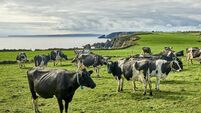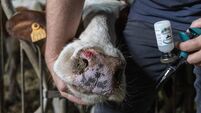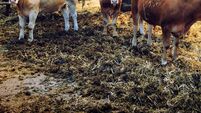Don’t buy any old silage to fill winter feed gap
Most have discovered that stocks are much tighter than they had thought before Christmas.
This trend has been confirmed by a Teagasc survey which found that about 33% of farmers have a fodder deficit.
The message remains the same: don’t just buy any old silage to bridge the gap.
It must represent value, and provide acceptable quality, to be worth bringing onto your farm.
Early turnout plans
Some farmers who are short on feed this winter are pinning their hopes on an early grazing season.
This is a high risk strategy. What will you do if you need to re-house, and have no fodder in the yard?
One option may perhaps be that you should at this stage have pinpointed fields that you are going to reseed this spring, and perhaps these fields may provide an opportunity to turn some stock out a little earlier, because you will be burning off the field.
Long list of jobs to do
This time of year is always very busy on suckler farms, and the list of jobs can be endless.
Calving will be high on the agenda for many, but try not to take your eye off other things that may need to be done around now.
Tasks both in the farmyard and around the rest of the farm must be tended to.
All going well, the grazing season is not too far away. Most beef farms will be targeting a turn-out date in mid-March or thereabouts.
This will obviously depend on land type, stocking density and the great unknown of the Irish weather.
It may be up to 10 weeks away — but plans need to be put in place in order to have sufficient grass at turn-out so that cattle can remain out full-time.
Fertiliser and Slurry
With this in mind, it is important that strategies are put in place to get the very best use of slurry on your grazing ground, in conjunction with efficient use of bag fertiliser.
Treat slurry as an important asset, and try to use it wisely to reduce your overall beef production costs.
With regard to fertiliser, it is important that you use the correct product, based on the nutrients required by your soils.
If you have recent soil test results, use these to devise your nutrient strategy.
Learn from fertiliser responses from recent years; many will comment that certain areas or fields are less responsive to urea than they are to CAN.
Cropping decisions
With the difficulties of 2012, many are re-assessing their cropping strategies, going forward.
For some, it will mean not growing alternative crops which were unsuccessful in 2012.
For others, it will mean deciding not to put all their eggs in the one basket in the form of unreliable grass silage, and considering alternatives such as whole-crop, maize or beet.
Whatever you are considering, base your decisions on solid facts and figures, and not just hearsay.
Figure out why crops grown were not successful, before abandoning them.
Was weather the only cause, or was the field unsuitable, or was crop agronomy up to scratch?









